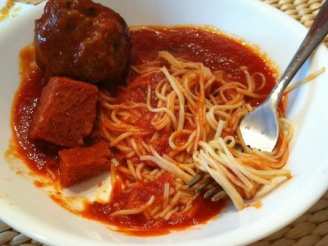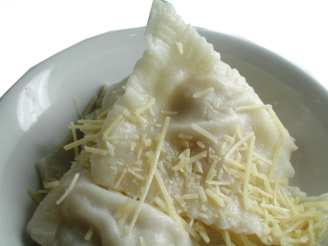Community Pick
Perfect Homemade Pasta or Spaghetti for Kitchenaid Mixers
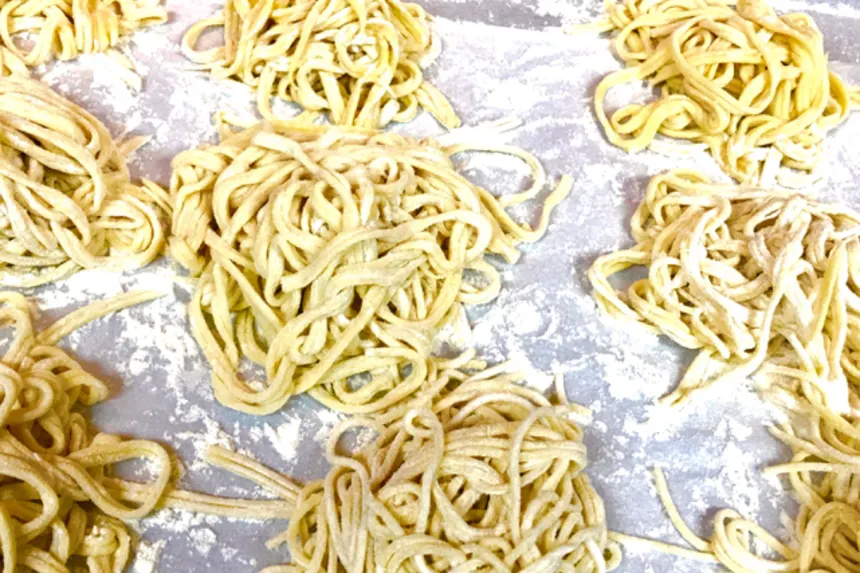
photo by Jeff Cheffro White

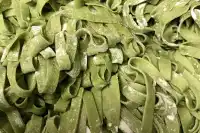
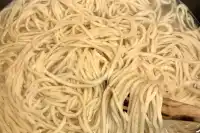
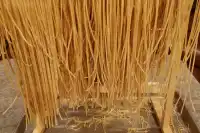
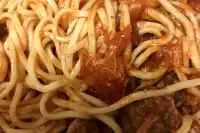
- Ready In:
- 2hrs 15mins
- Ingredients:
- 6
- Yields:
-
1 1/2 pounds fresh pasta
- Serves:
- 8
ingredients
- 2 cups semolina flour
- 2 cups all-purpose flour (I prefer bread flour for higher gluten)
- 2 large eggs, well beaten
- 1 tablespoon extra virgin olive oil
- 1⁄2 teaspoon salt
- 1 cup cold water
directions
- Combine the semolina flour, all purpose flour, and salt in a large bowl. Using a fork, mix these ingredients together, then using a sifter, sift into another bowl. Set aside.
- In a separate bowl, combine the eggs & beat well with a fork.
- Add extra-virgin olive oil to the eggs and mix with a fork.
- Add the cold water to the egg & olive oil mixture, and mix with a fork.
- Pour the liquid ingredients into your mixer bowl and attach the flat beater.
- Add half of the sifted flour mixture, turn to speed 2 and mix 20 seconds. Add the rest of the sifted flour mixture and mix an additional 20 seconds.
- Exchange flat beater for the dough hook. Turn to speed 2 and knead for 2 to 3 minutes, until a dough ball is formed.
- Remove dough from bowl and hand-knead for 2 to 3 minutes. NOTE: Good pasta dough should be elastic and pliable, but FIRM (not soft like bread dough). It should not stick to your fingers or fall apart. To test for the correct consistency, pinch a small amount of dough together after kneading for 2 to 3 minutes -- if the dough stays together without sticking to your fingers or falling apart, it should work well. If too soft, add more flour by dusting the top of the dough and knead some more, continuing to dust the dough with flour until achieving the right consistency. If too dry, wet your hands and knead some more, continuing to wet your hands a little at a time & knead until the right consistency. (Achieving the right consistency isn't hard at all -- I got it just right the very first time I tried this recipe).
- Wrap dough in plastic wrap and put in the refrigerator for a minimum of 1 hour (this step is important).
- Remove dough from refrigerator and let it rest for 15 minutes. Using your hands, roll dough into a log, about 12 inches long.
- Cut log into 8 slices, then flatten each piece slightly. Spread slices out so they aren't touching and cover with plastic wrap.
- Using the widest setting (1 on the Kitchenaid), turn mixer to speed 2 and taking one piece of the flattened dough, feed through rollers. Fold dough in half & roll again. Repeat 3 more times, lightly dusting the sheet of pasta in between each rolling if it feels the slightest bit sticky.
- Move adjustment knob to setting 2 and feed the dough sheet through the rollers once.
- Move adjustment knob to setting 3 and feed the dough sheet through the rollers once.
- Continue to increase roller setting until desired dough thickness is reached: 3 for Thick "kluski" type egg noodles; 4 for standard egg noodles; 4 or 5 for lasagna noodles, fettuccine, spaghetti, and ravioli; 6 or 7 for tortellini, thin fettuccine, and linguine fini; 7 or 8 for VERY thin "angel-hair" type pasta/capellini or VERY fine linguine.
- Separate sheets once desired thickness is achieved with a thin towel or piece of plastic wrap dusted with flour, so the dough doesn't dry out too much.
- To cut the noodles, exchange the Pasta Roller Sheet attachment for the cutter attachment of choice, either the fettucine cutter for wider noodles or the spaghetti cutter for spaghetti or linguine. Run each sheet through the cutter. NOTE: Each sheet can be cut in half or thirds before putting through the cutter to prevent "too long" of strips. I prefer to use the longer sheets, rather than cutting them in half or thirds, as this reduces the time it takes to cut each sheet & hang to dry.
- After cutting each sheet, hang to dry on a pasta rack. Dry for a minimum of 10 minutes. If you don't have a pasta rack, plastic hangers work great! IMPORTANT: Flour the pasta rack or the plastic hangers before placing pasta on them. ALSO, separate the strips of pasta as best you can, so they aren't touching. This way they won't dry sticking together. If you want to dry the pasta for later use, dry for several hours and then store in airtight plastic bags (i.e. Ziploc Freezer or Storage Bags).
- When ready to cook, boil your water and add salt. For the 1.5 pounds of pasta, I use 2 teaspoons of salt. Oil in the water is not necessary.
- Fresh pasta will cook faster than commercially bought pasta -- about 4 to 5 minutes in vigorously boiling water for el dente.
Reviews
-
This was my first attempt at pasta and I followed the recipe to the letter. Who puts a whole cup of water into 4 cups of flour??? It all went into the garbage. I realize now that I should have compared this recipe to a couple of others before starting, it was so sticky that even adding lots of flour wouldn't help it. All the other recipes that I've looked at only call for a couple of tablespoons, if that much. Obviously Chef #1535269 didn't follow your recipe blindly and "added water as needed" the smarter way to go.
-
I have a Kitchenaide pasta roller and cutter and have used the recipe included in the instruction book. Today I tried this recipe and followed it exactly. I added the entire 1 cup of water to the wet mixture as per the instructions; I did not "add water as needed." The recipe worked perfectly. In the hand-kneading step I just had to dust with flour (a minimal amount) one time to get the right texture. I'm not sure why this did not work for you Chef #286359. For me this was definitely not too much water and I didn't veer from the recipe at all. <br/><br/>This is now my go-to basic pasta recipe. Thank you for this.
-
Perfect indeed. I followed the recipe to a T as far as the quantities were concerned. I put the flours and salt in the kitchen aid bowl, stirred them then added the eggs and oil and then the cup of water. It came together beautifully. No extra water required. I let the machine knead it for a couple of minutes and then let it sit at room temperature for 40 minutes and then put it through the machine. I made ravioli on setting 8 which was too thin. The next batch I made on setting 4 which was a bit thick. I will try 5 or 6 next time. It is a perfect recipe for the dough. I read some comments here from people saying it didn't come together - not sure why. Anyway, thanks for sharing. I like the fact that it does not use too many eggs and uses a combination of eggs and water. I really wanted to leave a review so went through the hassle of creating a login which I usually hate to do. I hate even more, logging in with my other social media accounts.
-
I had never made pasta before and I love to cook. So I don't know why I was afraid to attempt the pasta. But this was a simple recipe. <br/>Only changes I made was using all regular flour, no semolina, added a total of 3 eggs, and increased olive oil by 1extra TBL.<br/>I made ravioli at Christmas like my mom did every year before she passed away. This made me feel really good about myself and I know I pleased my mom!!<br/>Now I've made pasta 3 times since Christmas already!! Very psyched about this and experimenting with different kinds of pasta's!!!<br/>Thank you for this recipe !!!!!!!
see 48 more reviews
Tweaks
-
Flawless recipe. My first time making pasta with my Kitchenaid was a huge success because of it. I only had smaller eggs on hand, so I used 3 eggs instead of 2, and with some concern about the amount of water in the recipe, I poured in 3/4 of a cup instead of the whole cup. The dough hook worked wonders with the dough (I don't even know how much hand kneading was necessary), and it was the perfect consistency. I dusted the sheets of pasta fairly liberally throughout the whole process to avoid stickiness and hung the pasta on clean flour-dusted coat hangers. Due to the length of the process, I felt compelled to refrigerate the first half of the pasta sheets I made before putting them through the fettucine maker. This may have been a mistake when using plastic sheet because the sheets came out with too much moisture and I had to re-flour. The pasta cooked perfectly in 3 minutes and we enjoyed it with a fresh tomatoes sauce, heavy on the basil and garlic. Thank you for making our first homemade pasta experience so easy!
RECIPE SUBMITTED BY
Neeney
Genoa, Illinois







.jpg)

